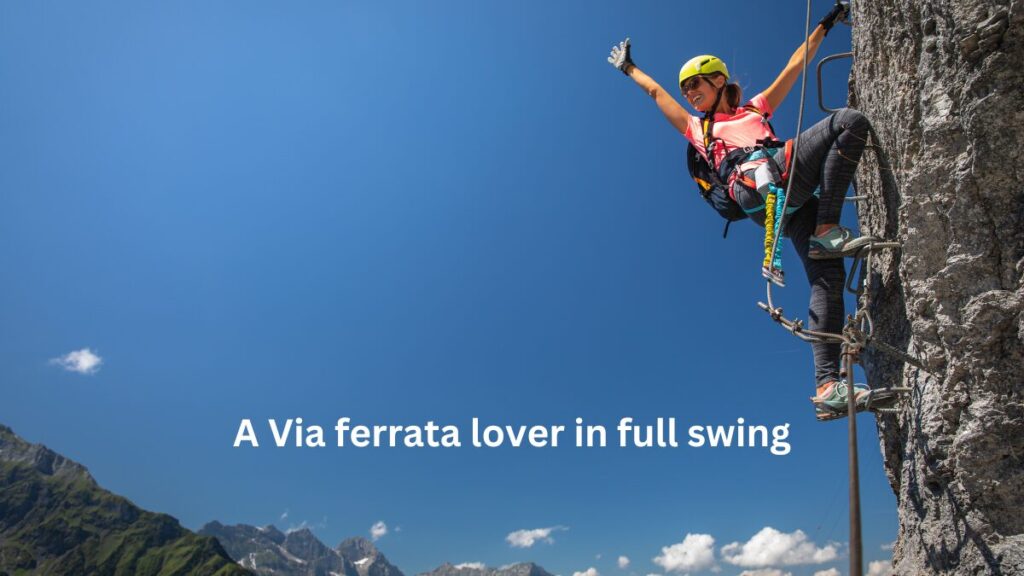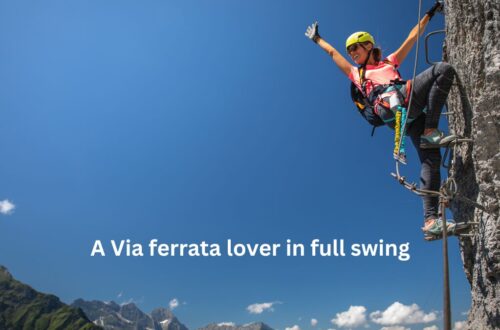Seewand Klettersteig: A Guide to one of Austria’s best Via Ferrata’s.
Right in the heart of Salzkammergut region, the Seewand Klettersteig is one of Austria’s best Via Ferrata’s. Towering above the serene Hallstättersee, this route has a blend of natural beauty, technical difficulty, and physical endurance. With dramatic ascents and sweeping panoramas, Seewand Klettersteig is not for the faint-hearted but promises unparalleled rewards for those brave enough to tackle it.

Overview
Seewand Klettersteig is one of Austria’s toughest via ferratas, graded D/E (difficult to extreme) on the international via ferrata scale. Spanning approximately 820 meters in elevation gain, this route is an unrelenting vertical climb that tests your mental and physical strenght. The route is open primarily from late spring to early autumn, depending on weather conditions, and requires a full day to complete.
Preparation: What You Need to Know
Fitness and Experience: Seewand Klettersteig is best suited for experienced climbers who are comfortable with exposure and have prior via ferrata experience. The steep, exposed sections and limited resting points demand excellent physical conditioning and a head for heights.
Equipment Checklist:
- Via Ferrata Set: Ensure you have a certified via ferrata harness and lanyard with energy-absorbing capability.
- Helmet: Falling rocks are a hazard, so a sturdy climbing helmet is essential.
- Climbing Gloves: To protect your hands during prolonged contact with the cables and rock surfaces.
- Sturdy Footwear: Approach shoes or lightweight climbing boots with excellent grip are ideal.
- Backpack: Pack water, snacks, a first-aid kit, and a lightweight jacket. Ensure your bag doesn’t impede your movement.
Weather Considerations: Weather can change rapidly in the Alps, and climbing in wet or stormy conditions is dangerous. Check forecasts before your climb and start early to avoid afternoon thunderstorms.
Getting There
Seewand Klettersteig is accessible from the picturesque village of Obertraun, near the world-famous Hallstatt. The trailhead begins at the base of the Seewand wall, a towering limestone facade that dominates the landscape. From Obertraun, follow signs to the parking area near Winkl, where the approach trail begins.
The Approach
The approach to Seewand Klettersteig is a steep hike through dense alpine forests, taking approximately 1 to 1.5 hours. The trail is well-marked but requires careful navigation as it ascends sharply toward the base of the wall. This section serves as a good warm-up for what lies ahead, offering glimpses of the lake below and the towering cliffs above.
The Ascent
Initial Sections: The climb begins with a moderate C-rated section, allowing climbers to acclimate to the exposure and rhythm of clipping and unclipping the safety lanyard. The limestone rock provides excellent grip, but the vertical nature of the climb becomes apparent quickly.
The Crux: Midway through the route, climbers come to the crux—an unrelenting D/E section that demands strength and precision. This stretch involves overhanging segments and narrow ledges, without many opportunities for resting. Focus on maintaining three points of contact and using your legs rather than your arms to conserve energy.
Exposed Ridges and Vertical Walls: The latter sections of the climb feature exposed ridges and airy traverses that give great views of Hallstättersee and the surrounding peaks. This part of the route is both mentally and physically taxing, but the sense of accomplishment grows with every meter gained.
The Summit
After hours of intense climbing, the Seewand Klettersteig culminates at the Gjaidalm plateau, approximately 1,400 meters above the lake. Here, climbers are rewarded with panoramic vistas of the Dachstein massif, Hallstatt, and the verdant valleys below. The summit area is a perfect spot to rest, rehydrate, and savor the sense of achievement.
The Descent
Descending from Seewand Klettersteig is an adventure in itself. The most common route is a marked trail leading to the Gjaidalm hut, where climbers can enjoy a well-deserved meal and refreshments. From there, a cable car can take you down to Obertraun, or you can opt for a scenic hike back to the village. Ensure you plan your descent carefully, as the trails can be steep and challenging, especially after a long day of climbing.
Click here for info about another awe-inspiring Austrian Via Ferrata.
Tips for Success
- Start Early: Aim to begin your climb at dawn to maximize daylight and avoid afternoon storms.
- Hydrate and Fuel: Carry at least 2 liters of water and high-energy snacks to keep your energy levels up.
- Pace Yourself: Climbing at a steady, sustainable pace will help conserve energy for the more demanding sections.
- Respect the Environment: Follow Leave No Trace principles to preserve the pristine alpine landscape.
Safety Considerations
Seewand Klettersteig is a serious undertaking with inherent risks. Climbers should:
- Monitor weather conditions closely.
- Ensure their equipment is in excellent condition.
- Avoid climbing alone; having a partner or group enhances safety.
- Be prepared to turn back if conditions deteriorate or if the climb becomes overwhelming.
Click here for another fantastic adventure in Austria.
Nearby Attractions
The Salzkammergut region is a treasure trove of natural and cultural wonders. After conquering Seewand Klettersteig, consider exploring these nearby attractions:
- Hallstatt: This UNESCO World Heritage village is renowned for its charming architecture, historic salt mines, and picturesque setting on Hallstättersee.
- Dachstein Ice Cave and Mammut Cave: Located near Obertraun, these spectacular caves offer a fascinating glimpse into the region’s geology.
- Five Fingers Lookout: Accessible via the Dachstein Krippenstein cable car, this viewing platform offers stunning vistas of the Dachstein Alps.
Click here for a fabulous selection of European adventures.
Conclusion
Seewand Klettersteig is more than just one of Austria’s best Via Ferrata’s; it’s a journey into the heart of Austria’s alpine grandeur. While its challenges are not to be underestimated, the sense of accomplishment and the breathtaking beauty make it a must-do for experienced climbers. With proper preparation, determination, and respect for the mountain, tackling Seewand Klettersteig is an adventure that will stay with you forever.

